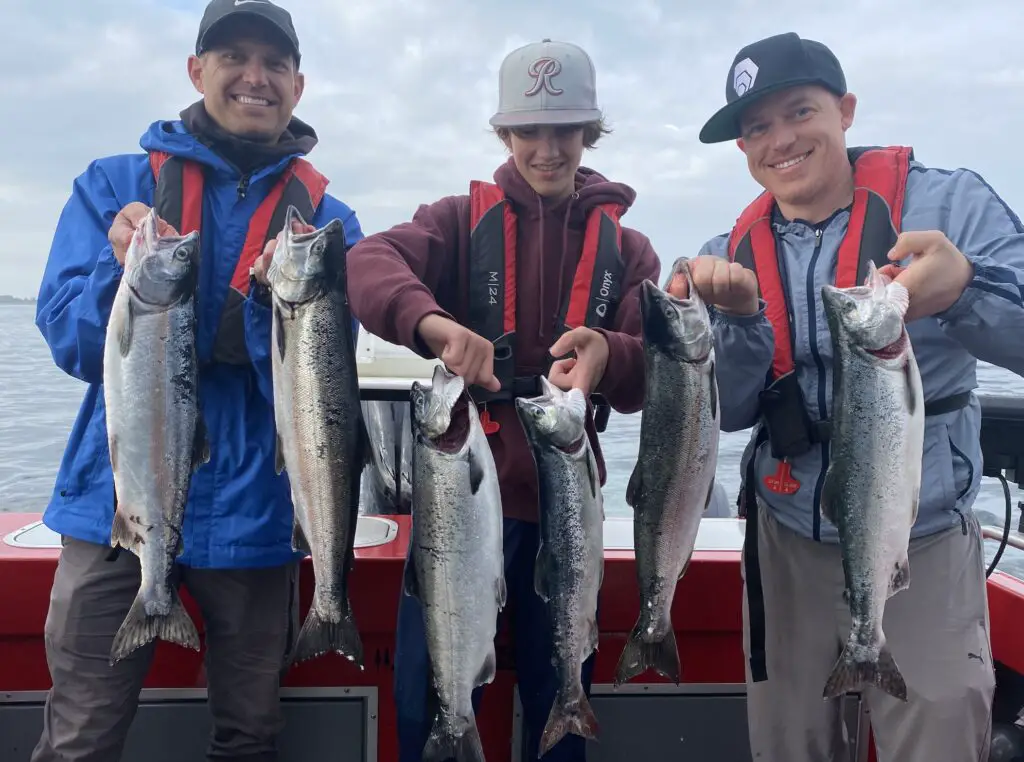
In this article on Puget Sound salmon fishing, I cover the best fishing techniques, including species-specific factors, when the optimal times of the year are to fish, the best fishing locations, and rigging up our fishing gear for salmon, including lures and bait to use.
I’ve been fishing the Puget Sound and the surrounding areas for salmon for many years and conduct 50-70 trips per year, which has allowed me to acquire significant experience on salmon fishing in Puget Sound that I’m excited to share with you.
I also intend to update this frequently as I continue on my learning journey and discover new ways to share my learnings.
Let’s start with the basics:
The Puget Sound is a saltwater body of water near Seattle, WA, connected to the Pacific Ocean via the Strait of Juan de Fuca, but the Puget Sound sometimes also refers to the surrounding waters in the same vicinity for the purposes of fisheries management definitions.
The entire inland saltwater environment is referred to as the Salish Sea.
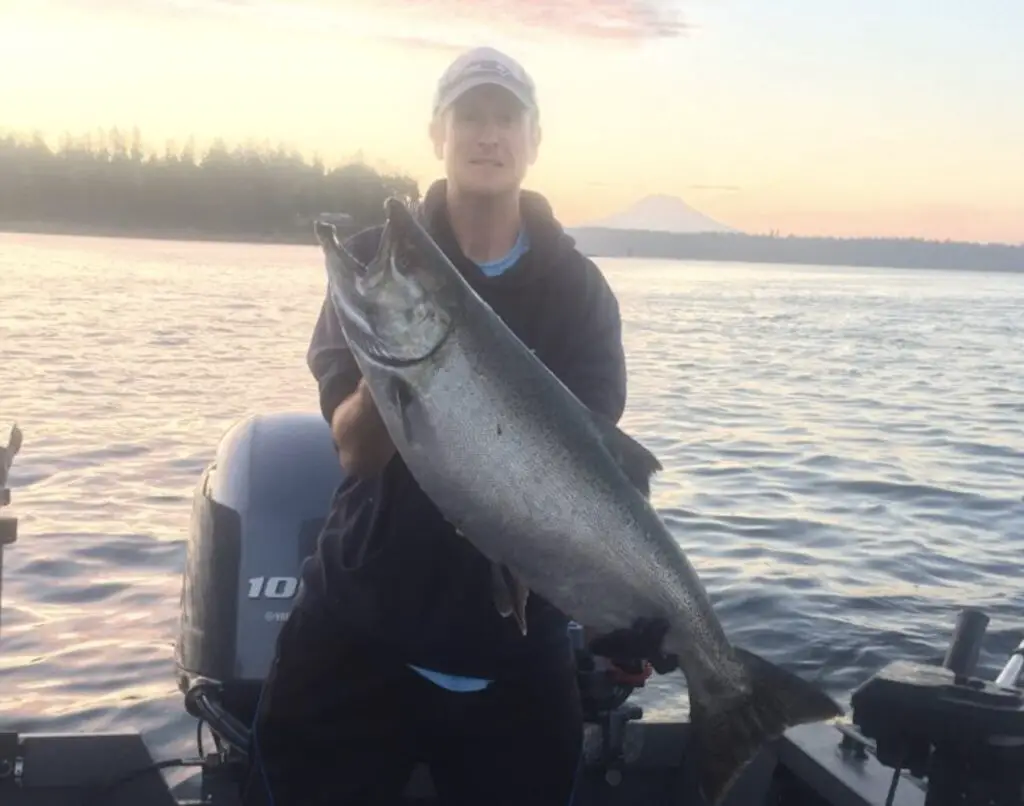
All five species of Pacific Salmon return to Puget Sound by the multiple millions (total for all) in a good year.
In addition to returning salmon, even more salmon smolts out-migrate from their respective rivers, which feed the Puget Sound, and either stay in the Sound and surrounding waters or migrate north and west to the rich feeding grounds of the Pacific Ocean along the coast of Canada and up to Alaska.
I recently completed a review of a great book covering the history of Puget Sound salmon runs that’s worth a read for anyone who wants to get into the incredible history of this area with regards to salmon.
WDFW fishing for salmon in marine areas basics is also a super helpful article for getting started
Puget Sound salmon fishing is a vast topic with a significant learning curve so give yourself lots of patience to learn and just enjoy being out on one of the most beautiful places in the world to fish!
Current Puget Sound Salmon Fishing Opportunities
Right now, on May 9th, 2025, the only option is to fish Marine Area 13. The next openers will be the Tulalip Bubble and Marine Area 10 resident coho in June. That’s always a fun warm-up to the main event in July when things really get going.
We should have exact season details soon as well.
Please refer to WDFW’s emergency rules page for a full list of recent rule changes.
Where is the best place to hook a Chinook / King salmon right now?
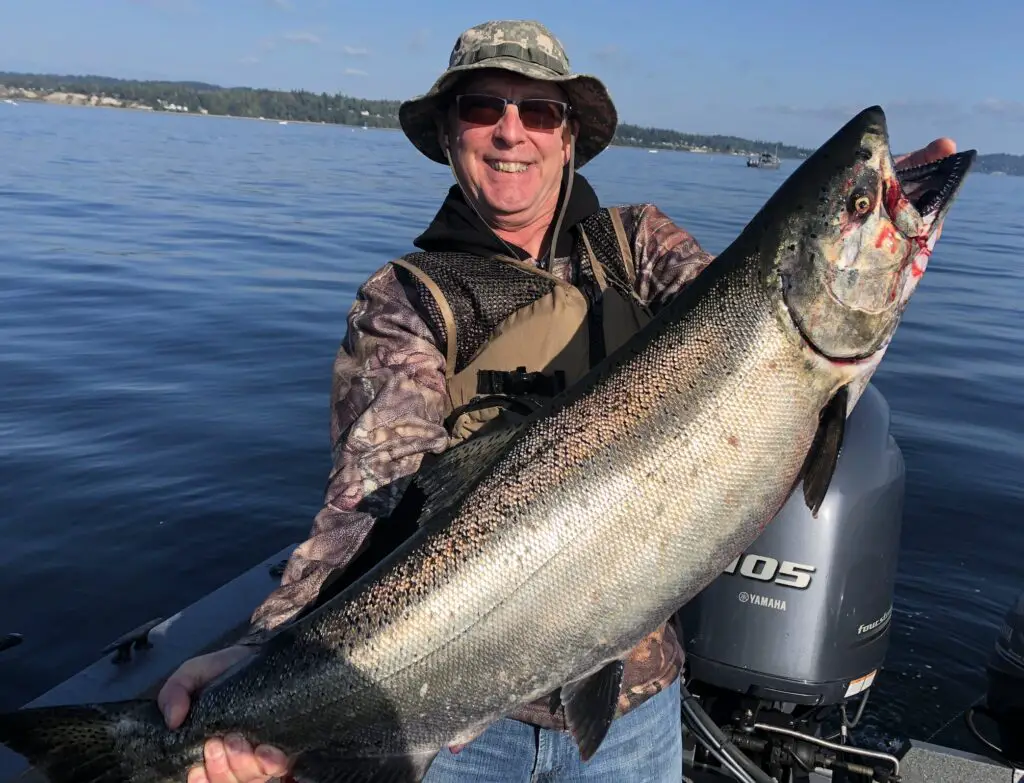
I’ve created this new section just to provide clarity on answering the question during the summer salmon season, and specifically for Chinook/King salmon, and I may also add the coho/pinks later on. Take a look at the graph below, which attempts to answer this question.
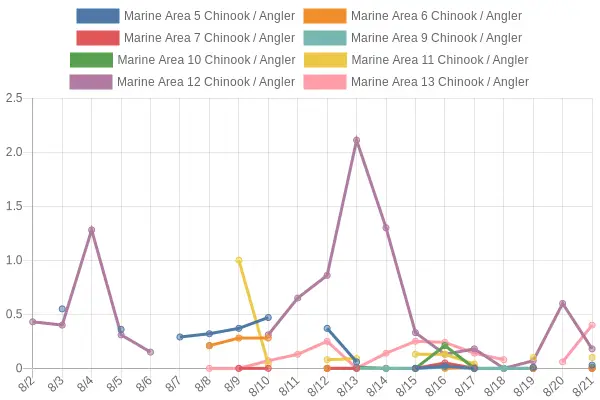
The graphs are updated automatically so check back whenever you want.
Latest posts related to fishing the Puget Sound
- How to Prepare for the 2025 Puget Sound Spot Shrimp Season
- Pink Salmon Run 2025
- 2025 Chinook Salmon Forecast for Puget Sound
- 2025 Puget Sound Pink Forecast
- 2025 Coho Salmon Forecast for Puget Sound
Fishing Techniques for catching Puget Sound salmon
There are a variety of techniques that can be leveraged to be effective at Puget Sound salmon fishing. Conditions may dictate one technique over the other, so it’s good to be aware of and master all of them.
- Trolling with and without downriggers
- Mooching
- Jigging
- Float fishing
Trolling with downriggers
You are going to want to checkout the extremely comprehensive guide to downrigger fishing for salmon as there’s so much good info there it deserves its own page.
Trolling without Downriggers
Many boats, mine included, aren’t set up with more than 2 downriggers, but desire to get more lines in the water (without stacking!) and some may not have downriggers at all. For fall salmon, downriggers are certainly not required to hook fish.
Two popular trolling approaches for salmon without using downriggers are fishing sinkers or using divers.
As an Amazon Associate, I earn a commission on any clickable product link. The price you pay is the same regardless, and you can support the blog by using these links to purchase. Also, I should mention that I use all of these products myself or they wouldn’t be on the page. Finding the right products can sometimes be challenging, so hopefully these links help!
Divers
There are many types of Divers one can purchase, but I’ve gravitated to the Deep Six diver for a few reasons:
I love the depth it can get to for being a serious alternative to downriggers, and it’s equipped with a clip/release that allows the diver to not create drag/diving action when a fish has taken the offering, which makes it easier to fight a fish on a diver-rigged setup.
I’ve hooked quite a few fish on these divers while also fishing with downriggers, so I know they can hold their own. Divers are designed to run deeper, the faster your boat is moving. Diving deeper with more speed is the opposite of what a sinker will do, that being to rise higher in the water column in response to more speed.
Sinkers
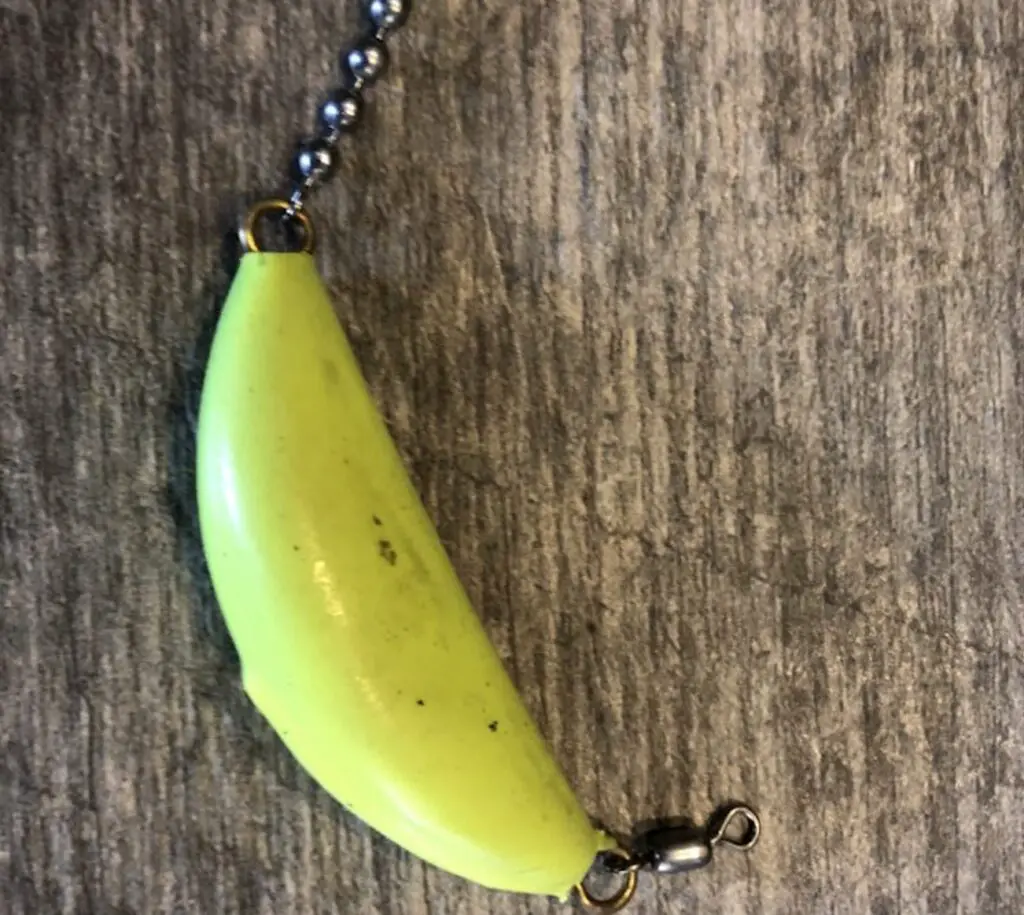
A sinker is a very simple option for getting trolling depth without a downrigger. If you are fishing for salmon closer to the surface, looking to get depth while moving more slowly, or are looking for a dual-purpose trolling/mooching setup, sinkers may be right for you.
If you find yourself adding more weight or having to troll slower than you want, to get depth, you may want to consider a diver instead.
Mooching for salmon
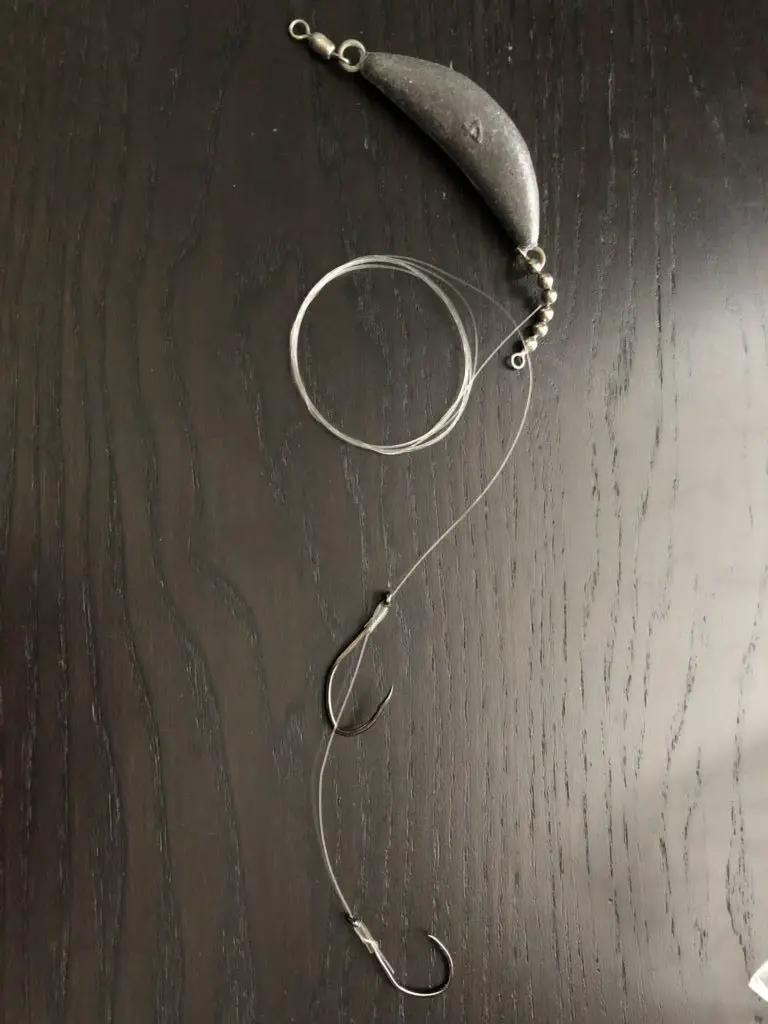
Mooching was invented in and has a long history of use in Puget Sound salmon fishing. As trolling for salmon with downriggers has become more prevalent, mooching has receded in popularity.
Mooching involves banana sinkers like the picture above and 5-7 ft leaders rigged with cut plug herring (we will explore bait presentations later in the article).
Typically, mooching involves drifting with the tidal currents, but can include motor mooching, which involves taking the motor in and out of gear to cause a gradual rise and fall of the bait, in much slower currents.
Mooching is best done with multiple baits in the water, as this can imitate a small school of herring and create more attraction for nearby salmon.
The key is to have some line angle (45 degrees) as you are dropping down, to avoid tangling the weight and leaders, and also to NOT set the hook right away when you feel a fish bite.
This can be a great rod-in-hand technique that gets anglers on your boat really engaged versus waiting for a strike on a downrigger while trolling. Generally, the process of mooching involves dropping down to the bottom and slowly retrieving and then dropping back down again as you drift from shallow water to deeper water on a good ebb current in good water for Kings.
The mooching technique can be especially deadly near kelp beds, in and around points, or in shallow bays/coves. The Strait has a lot of kelp beds, especially around Sekiu where you can have great results mooching. There are still folks that fish in the Puget Sound that still only mooch and do quite well. We wrote a how-to page for motor mooching specifically that may help you get started.
Jigging for Salmon
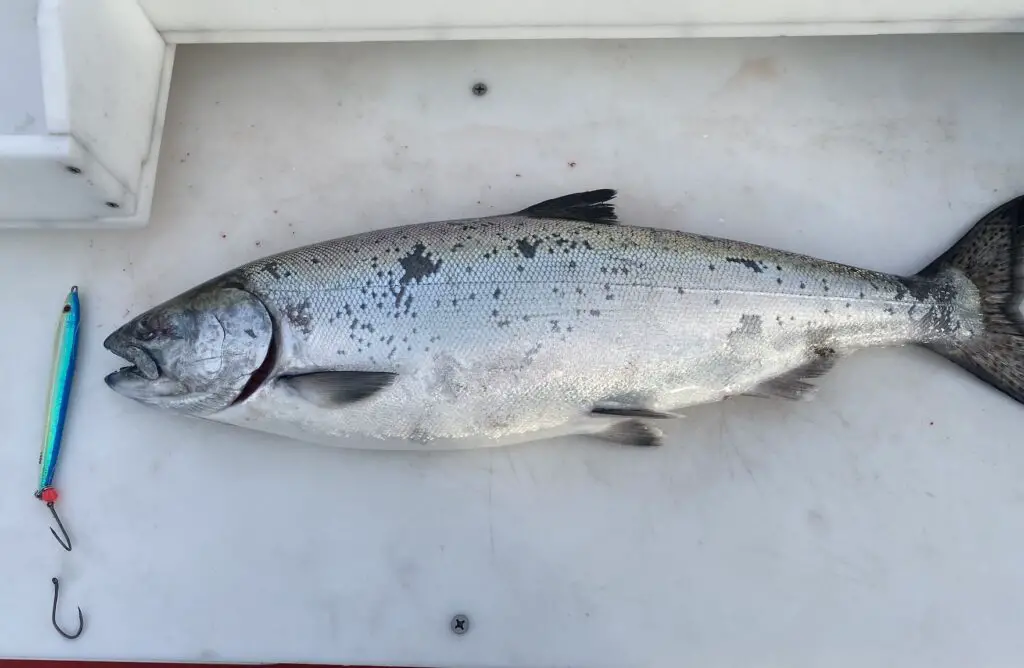
The key to jigging is all about line angle (staying vertical) and boat control. If your line has a serious angle to it, you are no longer fishing effectively.
The key attraction factor while jigging is the jig tumbling through the water column. Many times the bite will be felt while lifting the rod tip, but it’s the free fall of the jig that draws the strike.
To effectively jig, you need to be able to let your jig free-fall after raising your rod tip. It’s not necessary to move up and down by more than a few feet. Sometimes, even smaller motions can be more effective.
The jigging technique is especially useful in targeting fish near their natal streams that have kind of stopped feeding and are just stacked in an area, refusing to chase anything being offered on the troll.
When you find a pile of fish and cannot get them to go while trolling, you may need to park on top of them and go vertical via jigging. This is especially deadly during tide changes.
Float fishing for Salmon
This technique, while more associated with the rivers or even off of a beach or pier on the Puget Sound for Kings/Silvers, is also something that can be used from a boat to target Chum in particular within the Sound. Usually, this involves rigging whole anchovies under a float and working it really slowly in estuaries and places where Chum will school in massive numbers before they head upstream to spawn.
Species of Salmon found in Puget Sound
There are five species of Pacific Salmon found within the Puget Sound:
- King or Chinook Salmon
- Silver or Coho Salmon
- Pink Salmon also known as Humpies
- Chum Salmon sometimes referred to as Dog Salmon
- Sockeye Salmon or Red Salmon
King / Chinook Salmon Fishing Considerations
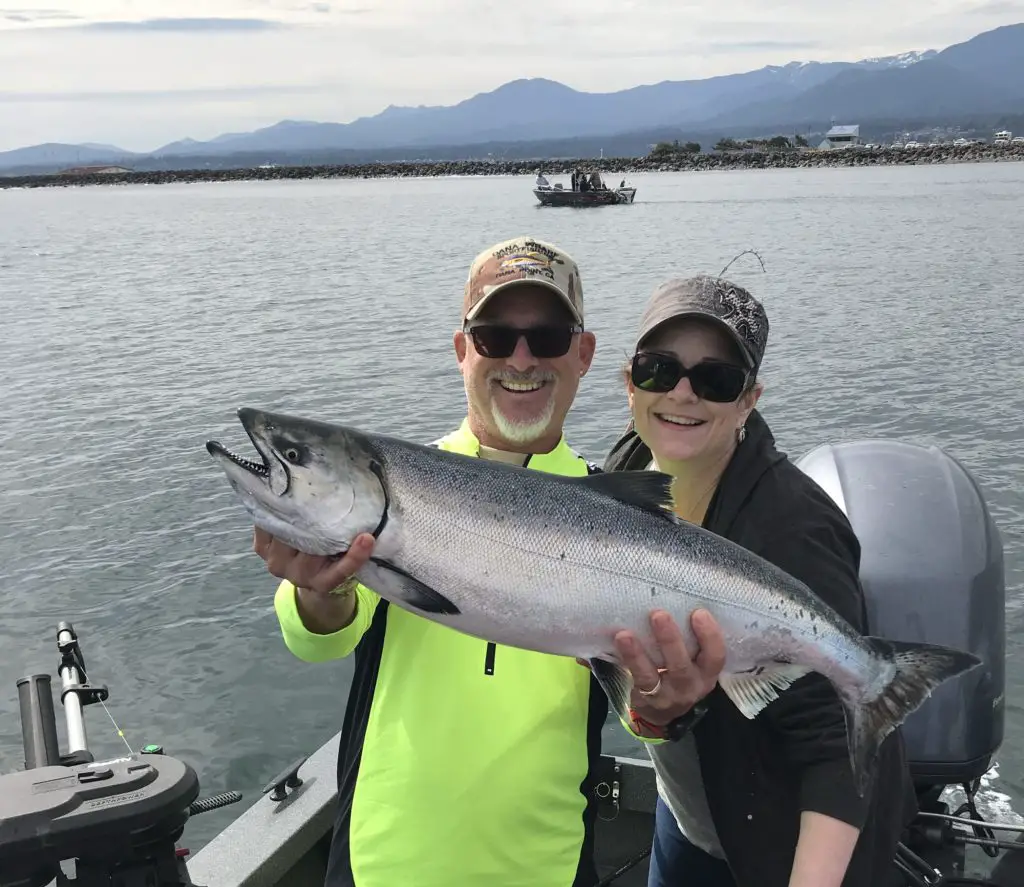
King/Chinook Salmon are the largest of the five species found in the Puget Sound. Sizes up to 40 pounds can be caught, though even a 30 pound fish is quite rare. Most derbies are won with fish in the high teens or twenties.
There are very few opportunities to fish for chinook salmon in Puget Sound these days due to the continuing declining status of natural origin chinook and the ESA listing of natural original Puget Sound chinook.
There are typically chinook salmon seasons during the summer months, but they are managed as quotas not seasons, which means, they can close early based on how many fish are being caught.
The chinook we can fish for during other parts of the year are known as “blackmouth”, which is a term used interchangeably with juvenile chinook out-migrating to the ocean and also adult chinook which have stayed within Puget Sound. Check out our page devoted to blackmouth fishing in the Puget Sound.
Trolling speed for King/Chinook Salmon
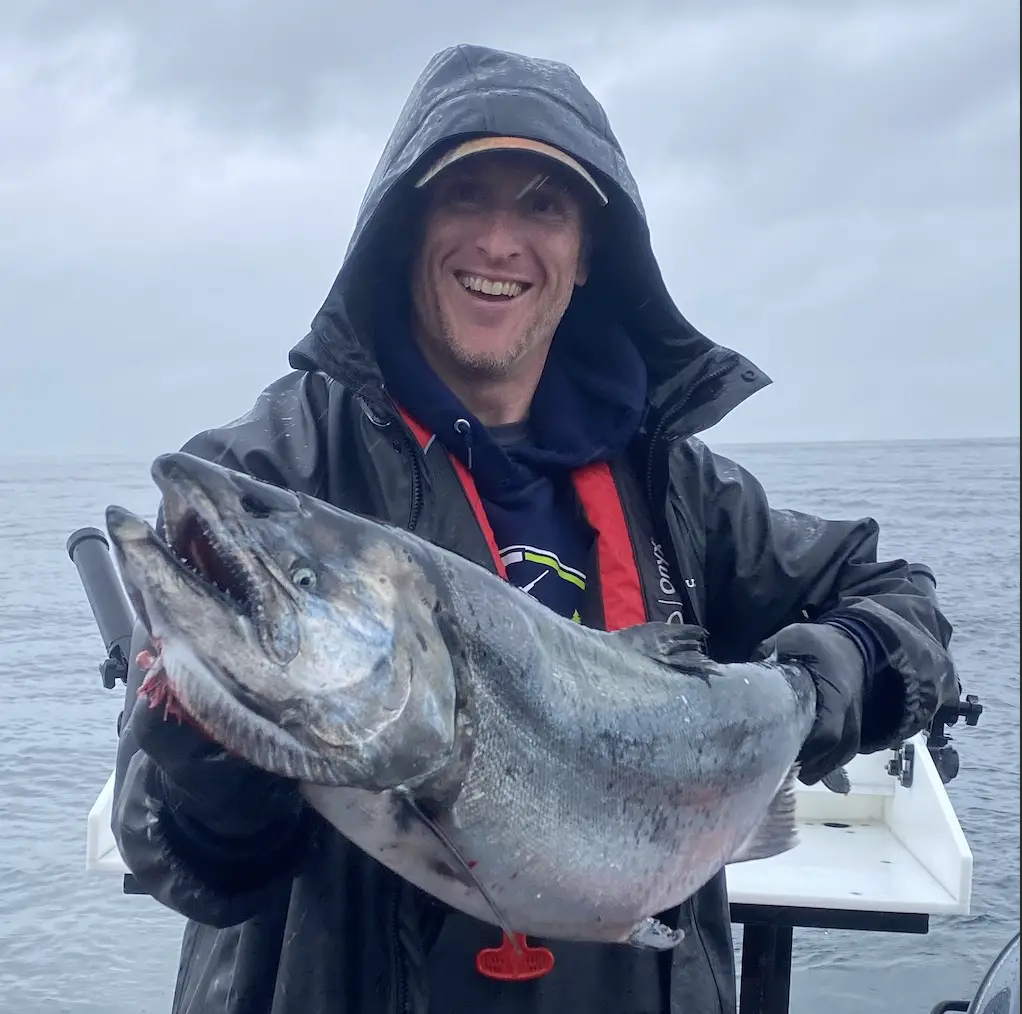
Kings can be caught at a variety of trolling speeds. Around 2mph is generally a good trolling speed, but there are scenarios to be aware of that call for variations.
In general, I’ve found that the closer to the terminal area you are (the river the salmon are headed for), the slower you need to troll. Salmon begin the spawning process (and thus the dying process) as they near their destination rivers and are less likely to chase your 3.5 mph speedy offering closer to their natal streams in the South Sound for example, as opposed to in the Strait or Admiralty Inlet for those same salmon.
Additionally, if you are trolling an offering such as a Hoochie or Ace High Fly which depends on the flasher to impart action, you may need to troll faster to get the appropriate action you are looking for.
This can also be accomplished by keeping a shorter and stiffer leader between your flasher and hoochie (such as 28-32″). If you are trolling bait or spoons, these have their own action independent of the flasher and 42″ or longer leaders are the norm along with also working at slower speeds.
Another factor in trolling speed is the current. If the current is moving you along at 1 mph and your boat electronics say you are moving at 2 mph. Your actual speed in terms of the effect on your gear in the water is actually only 1 mph (1+1 = 2).
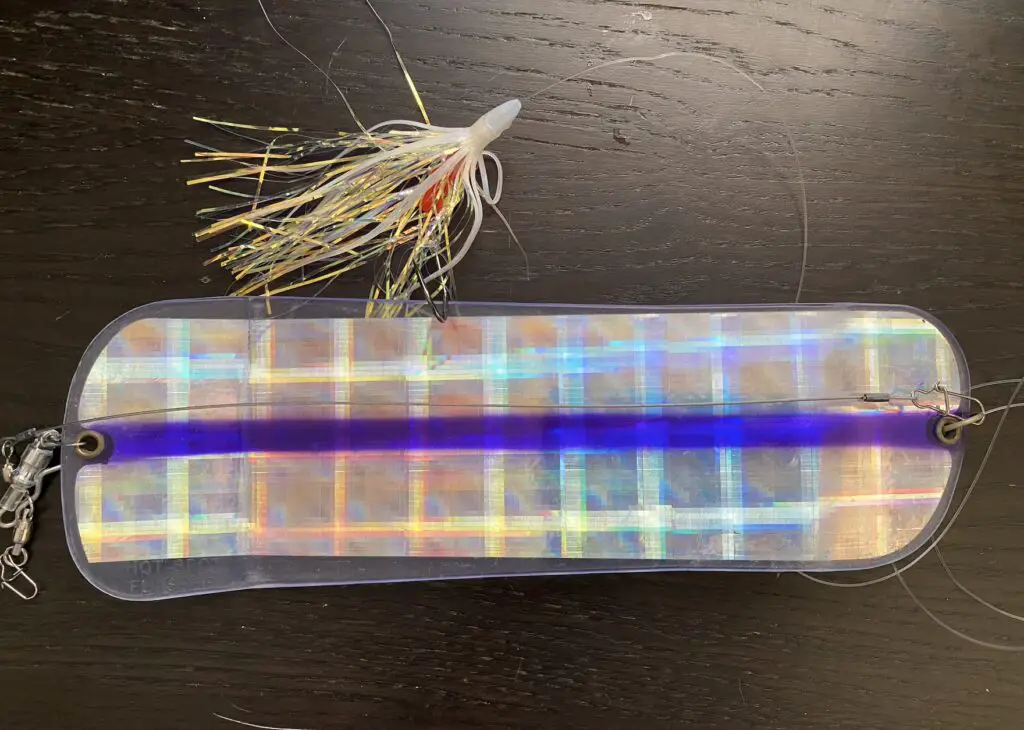
So, if you need to be moving 2 mph to get the right action on your hoochie or Ace High Fly with a 1 mph current, you want your electronics reading 3 mph. Simple, right?
In the same way, if you are going against a current of 1mph, and you want a 2 mph effect on your gear, you will need to travel at only 1mph according to your electronics. Sometimes, I look at the blowback angle of my downrigger wire to help maintain the right speed regardless of which direction I’m trolling.
In general, I like to troll fast for king salmon in the Strait or places like Marine Area 9 (even 10 early on in the season), 2.2-2.8 mph. As I target salmon in the South Sound that aren’t feeding as actively, I slow down to 1.5-2.2.
Fishing for chinook salmon in the South Sound is optimal with the hoochie or Ace High Fly approach, however, we now have the speed issue to worry about. The solution is to use the pro-troll flashers with the agitator fin, which spins well at slower speeds.
Add a herring strip to your Ace High Fly or hoochie (you can also use herring oil on the hoochie) and you’ve got a winning combination!
Depths for fishing King / Chinook Salmon in Puget Sound
Kings prefer structure, and they can be found in as little as 20-30 ft of water, all the way to 200+ plus.
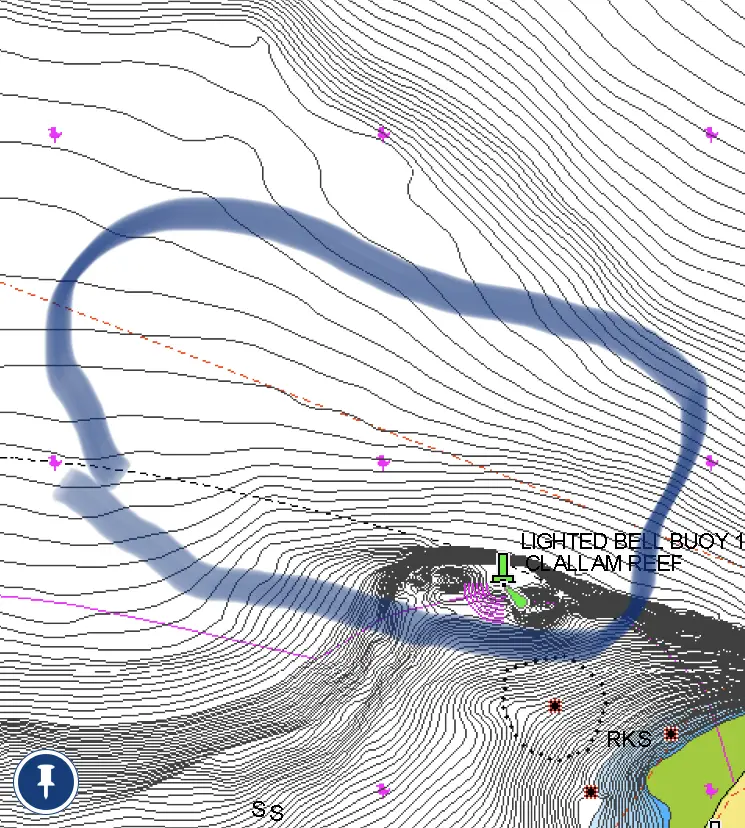
By structure, I mean points, a steep shelf where the depth drops rapidly, near shorelines, or submerged banks.
Bait will tend to congregate in these places due to tidal currents, and Kings are often found chasing bait such as herring in large schools around this structure. Returning adult salmon may be suspended and higher in the water column in the early part of the day or when traveling versus feeding. As the sun rises, they generally move down in the water column and into deeper water.
Blackmouth on the other hand are almost always found within a few feet of the bottom due to the prevalence of sand lance found on the bottom.

Common depths when trolling near the bottom for blackmouth are 80-160 ft. This may require slower trolling speeds to counter the blow back of your downrigger wire/braid. It’s also why some folks prefer braid. You can also compensate for that blowback by using larger downrigger balls. I use 15-20 lb balls when fishing for blackmouth so that I can troll at the right speed for my presentation and stay near the bottom.
Best times of the day to target king salmon
Kings are very light sensitive. While you can catch king salmon any time of the day, the best fishing will be at daybreak, at tide changes and again at sunset.
This axiom becomes more true the later into the season you get or the closer you are fishing to the return migration destination of the chinook salmon.
Fishing in June or July in places like the Strait or northern areas of Puget Sound is less about sunlight and more about fishing the right tidal currents.
Silver / Coho Salmon Fishing Considerations
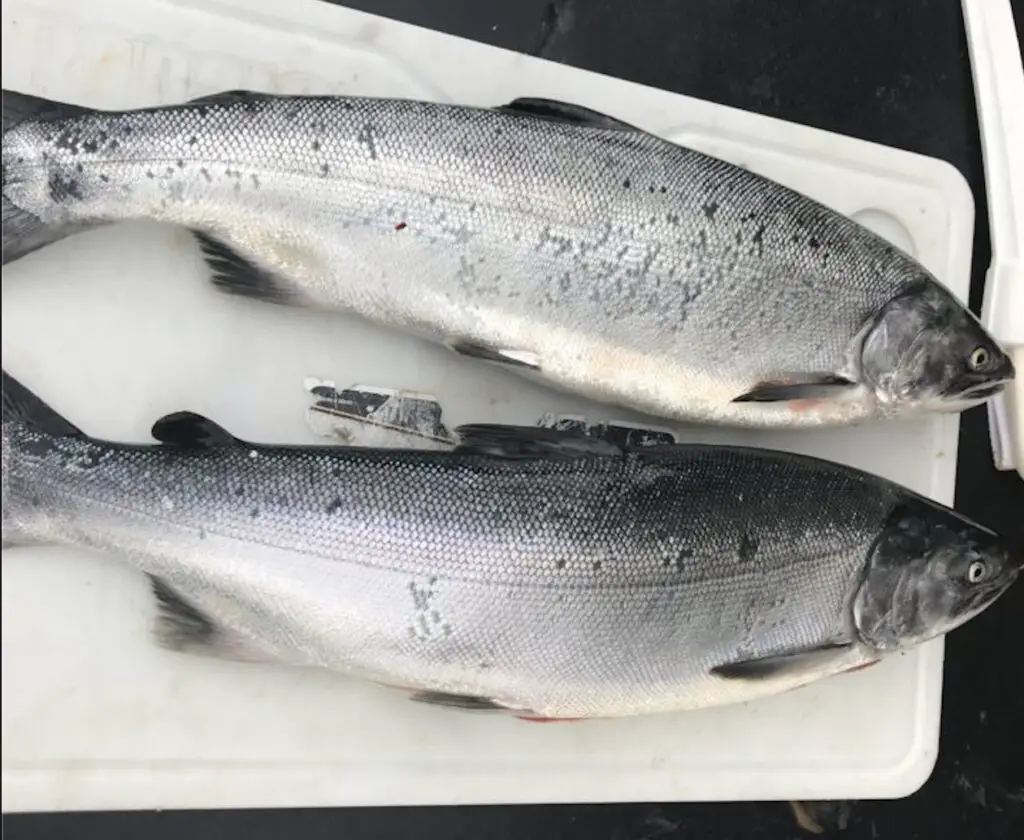
Silver / Coho Salmon are sought after almost as much as Kings and typically show in greater abundance. A fresh silver caught in the salt can be epic table fare! Most returning adult silvers are 5-10 pounds, but larger specimens up to 20 pounds have been caught.
Like Kings, you can also fish for coho a few other parts of the year outside of the late summer and fall when the adult fish are returning to spawn.
These year-round fish are referred to as “Resident Silvers/Coho”, which includes both silvers that have stayed within Puget Sound and out-migrating juveniles.
One of the most important factors to keep in mind when targeting silver/coho salmon is that these are schooled fish. Where you hook one, you will often hook several more.
Trolling for coho can involve long periods of ‘searching for the school” followed by an insane period of non-stop action, putting salmon in the boat before the school is lost.
Do donuts, figure-eight patterns, whatever it takes to find where you hooked that first coho salmon and get back on the school!
Trolling speed for Silver / Coho Salmon
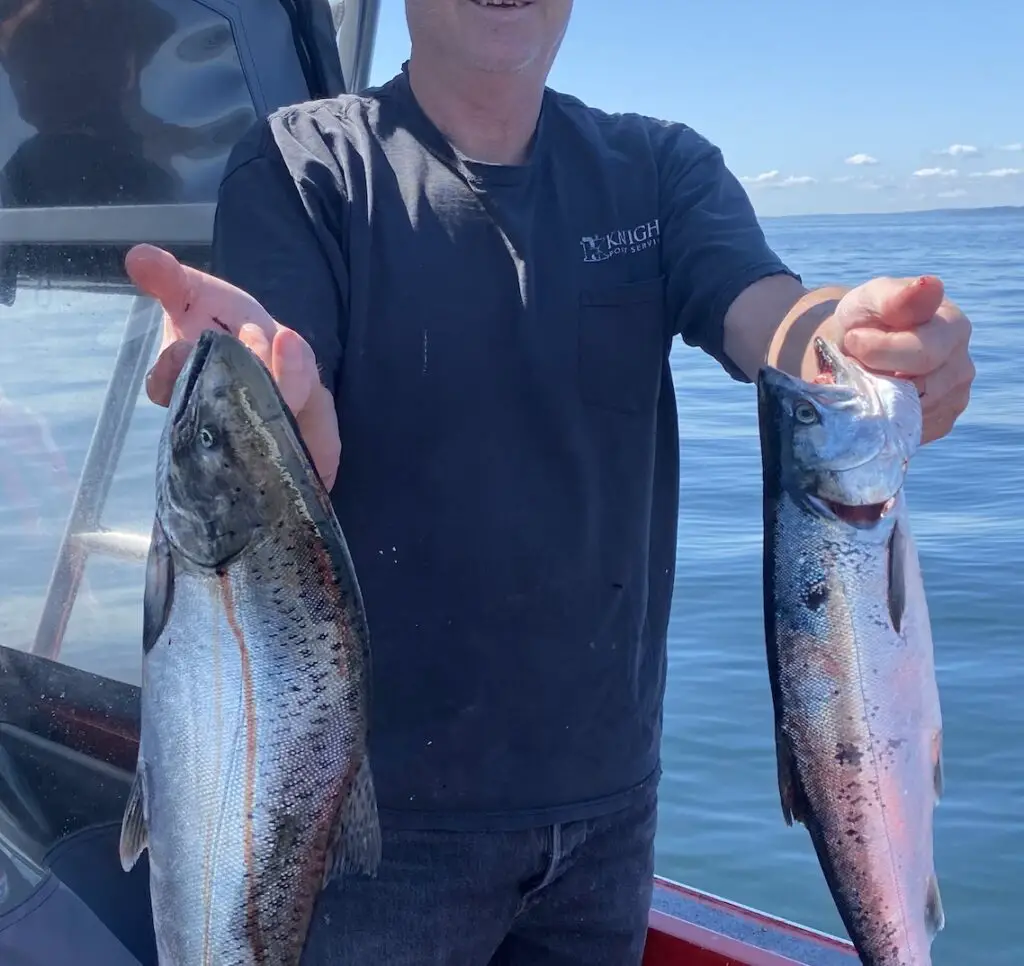
While you can certainly catch Silvers at the same trolling speeds as King, they generally prefer a bit faster trolling action. I generally aim for 2.5-3mph, but they can also be hooked at even faster speeds.
Remember, part of the issue with speed is related to factoring in the currents as well. If you are doing 2.5 mph in a 2mph current and fishing with hoochies or ace high flys you are unlikely to draw a strike.
These lures may require your boat speed to be at least 2mph plus the speed of the current to get the right action. So in the example above, this would be 2 + 2 = 4mph.
When the current is really ripping, I might be trolling 4-5 mph to get coho salmon to bite.
Depths for Silver / Coho Salmon
Silvers are generally found in far deeper water around tide rips and in the shipping lanes, but usually in the top 100 ft of the water column.
In the early part of the day, they may even be found very near the surface. They will also often chase a lure all the way up to the surface. Most folks who have put some time on the water for coho will have experienced the “behind the boat or on the surface” strike of an aggressive coho.
The approach is generally to start higher in the water column when fishing for coho and drop down 10 ft per hour as they may head deeper as the day progresses.
Sockeye Salmon Fishing Considerations
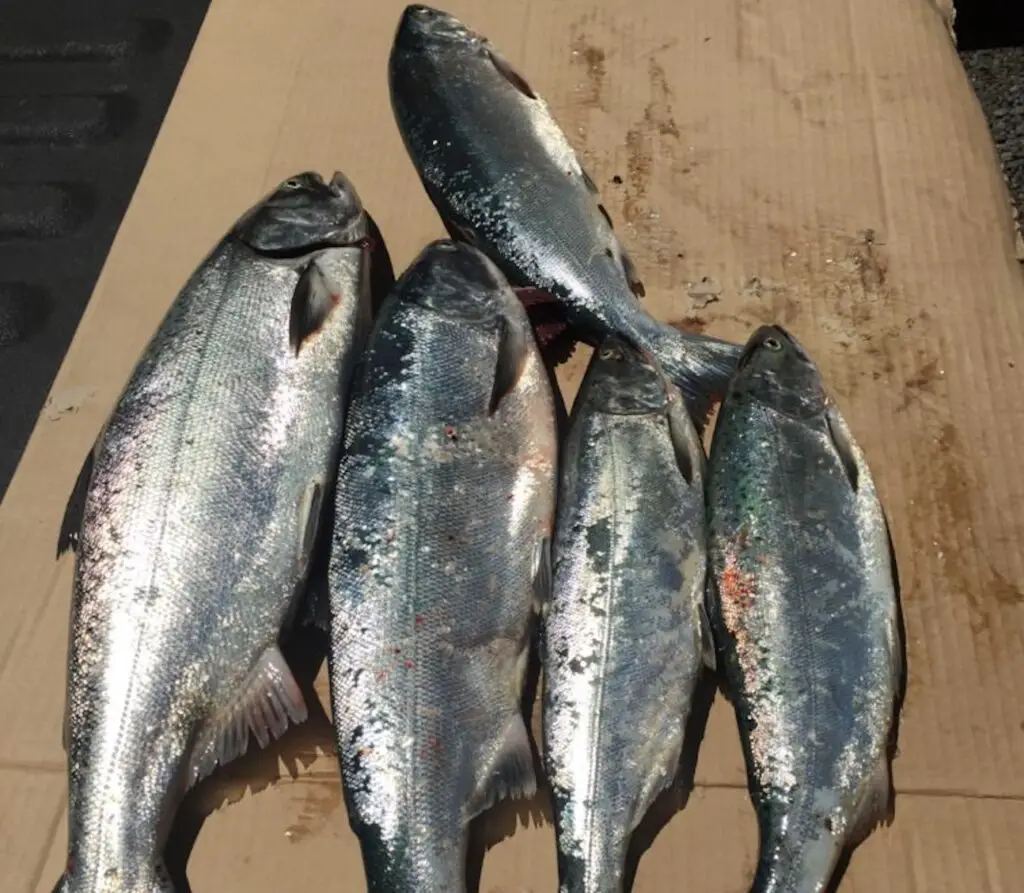
Sockeye can be very challenging to catch in Puget Sound. To have a chance, you need to be fishing the right areas that are along their route to their natal streams and lakes.
Only a few bodies of water even have runs of Sockeye. Those places are the Skagit / Baker Lake or Lake Washington.
Also, the Fraser River in British Columbia has a large run of Sockeye, and these fish can be caught around the San Juan Islands or the northern part of the Strait, where they are traveling through or staging prior to heading upriver.
My only experience with them in the salt water was in the Strait near Port Angeles.
Trolling speed for Sockeye Salmon
Sockeye prefer much slower trolling speeds, such as 1-2 mph. Most of the time with Kings / Silvers, you want to go with the current to cover lots of water, but I’ve found more success with Sockeye fishing the top 50 ft of the water column going against the current. If you can find a big school of them and troll slowly enough, you can find success.
Pink Salmon Fishing Considerations
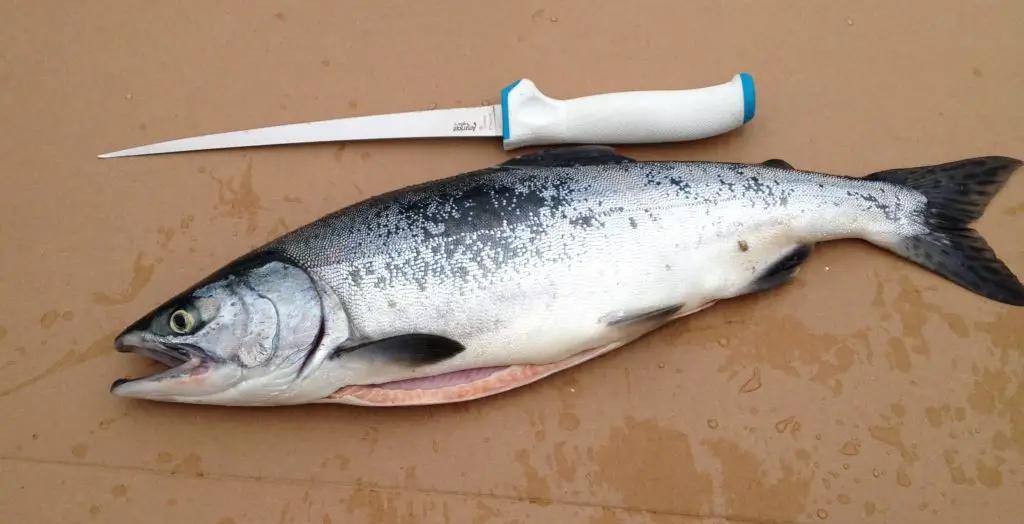
Pink Salmon or Humpies are the smallest of the species of salmon found in Puget Sound.
While some may disregard the table quality of Pinks, they can be excellent on the BBQ, but especially in the smoker when caught in the salt water or the lower part of their natal streams.
The lifecycle of Pinks lasts only 2 years and they generally only have a single year class of fish, which happens in odd years. So if you are targeting Pinks in the year 2020, you will be quite disappointed.
In the years 2025, 2027, and so on, however, you will have a chance at them.
Trolling speed for Pink Salmon
A slower trolling speed is also preferred for Pinks. In fact, if you find a big school of them, you may want to troll into the current to really slow down and keep your offering in their face for a longer period of time.
But really, if you find a big school of pink salmon you will probably struggle to catch anything but pink salmon!
Favorite technique for Pink Salmon
I absolutely love using a deep six diver, tying about 24-30″ of mono to an 8-inch white pro troll flasher with the agitator fin, and another 16-18″ inches of 20 lb flourocarbon to a pink ace high fly jr on a double hook setup with about 3-4″ from front to the trailer hook.
I have 2-3 pink beads above the top hook as well. This rig catches pinks, silvers, and even kings! It’s almost always on my shotgun rod out the back of the boat, and it sometimes out-fishes my downriggers.
Chum Salmon Fishing Considerations
Chum Salmon are the 2nd largest of all the salmon and can often top 20 pounds.
They are incredibly hard fighting and can be ok table fare if caught in the saltwater or early in a river system. Chum salmon also has a lot of oil that makes them smoke up really great, and also can help firm up their sometimes softer flesh. Chum typically return in massive numbers to the South Sound and Hood Canal. They are typically caught in the salt via float fishing with anchovies, but can also be taken with the aforementioned trolling techniques.
They are also very aggressive biters in the river.
Timing of Salmon Runs
It used to be possible to fish for salmon in Puget Sound almost all year round. Now, however, there are only a few opportunities outside of carefully managed often early closed summer seasons.
There are some distinct seasons to be aware of in terms of run timings for specific species and locations around Puget Sound.
Spring (Apr – Jun) Puget Sound Salmon Fishing
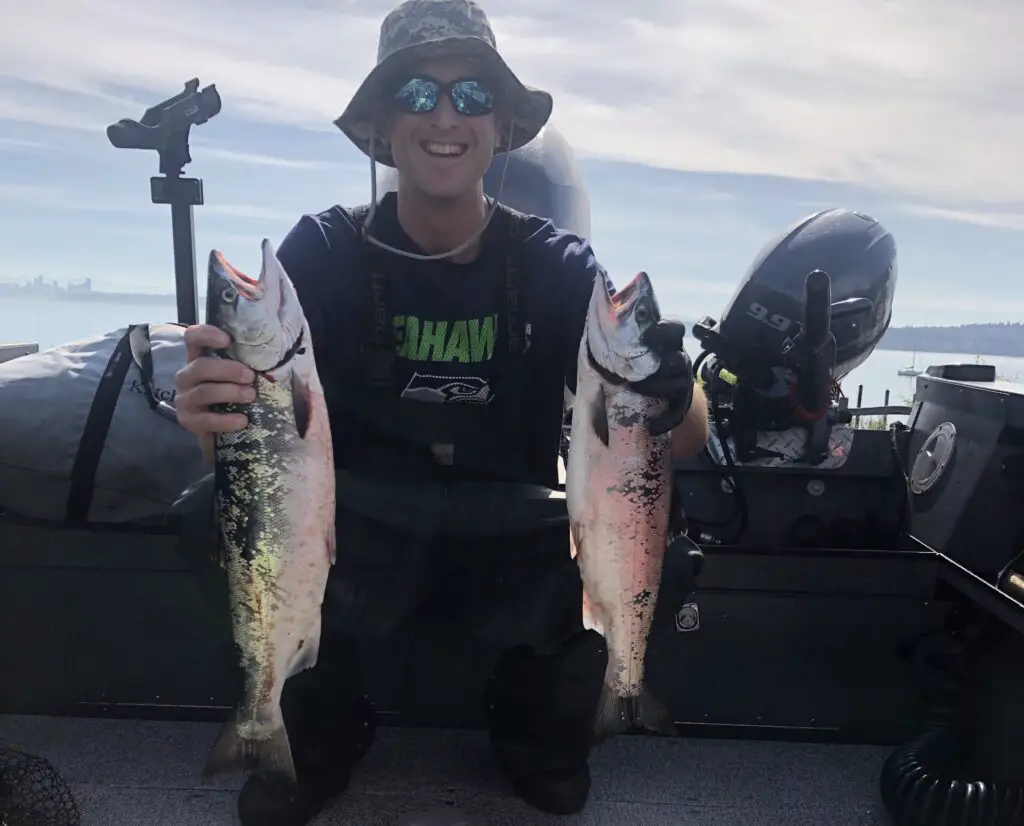
Regulations can change from year to year (always check the official regs!), but generally, most blackmouth seasons close sometime in April, and some much earlier due to quotas being reached.
The South Sound (Marine Area 13) typically stays open year-round, though there are certainly fewer blackmouth available there as most out-migrating juveniles will have made their way north.
June is really the beginning of the summer salmon season as some areas will open up for resident silvers and even kings in a few select areas. Some adult kings will have already made their way into the South Sound in the month of May/June, making Marine Area 13 sometimes worthwhile.
Summer (Jul-Sep) Puget Sound Salmon Fishing
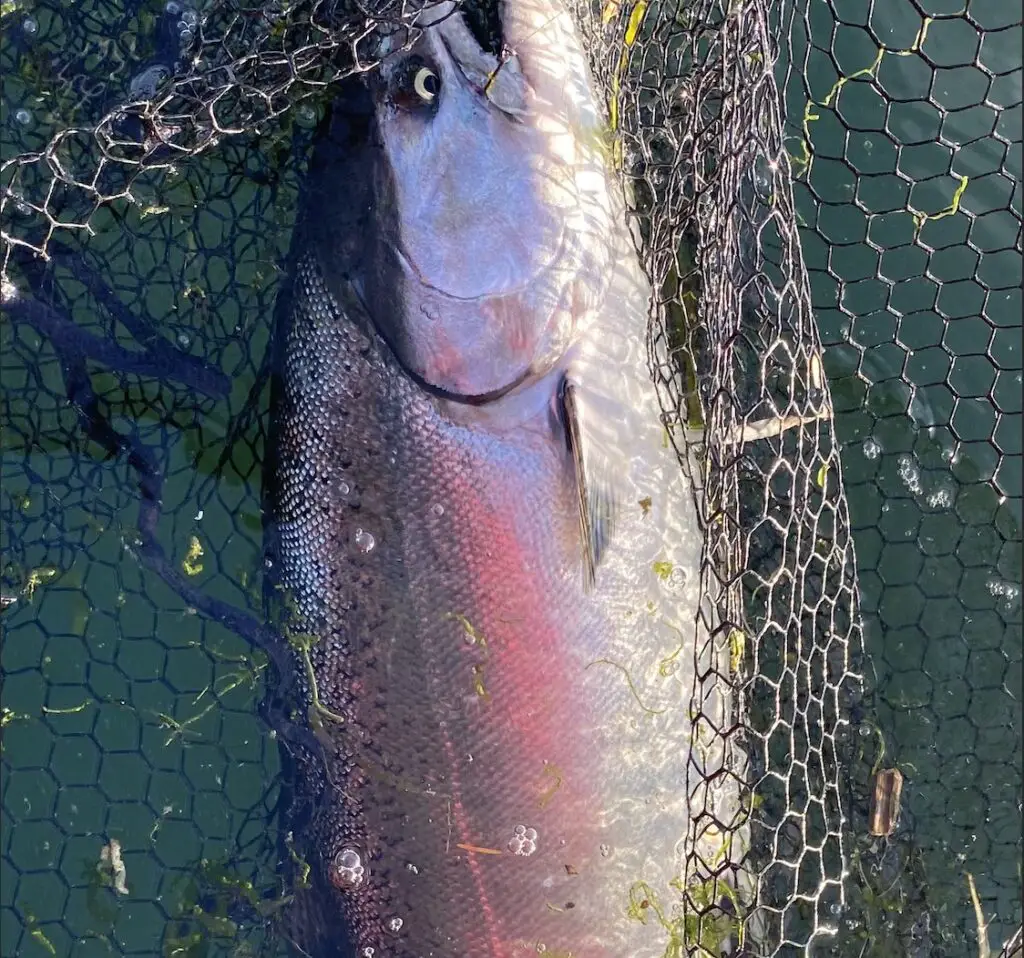
July through September are truly the peak of salmon fishing on Puget Sound.
Not only is the weather often exceptional, but the fishing can be as well. Marine areas will tend to open up starting from the west end of the Strait (Marine Area 5), followed by the east end (Marine Area 6) and into Admiralty Inlet (Marine Area 9) and the Central Puget Sound (Marine Area 10) as the month of July progresses.
Marine Area 11 near Tacoma/Vashon will sometimes have an early opening, but not really heat up until the end of July, when the majority of the run will be staging and beginning to head upriver to places like the Puyallup River.
It’s important to realize that, because of the concern for impact on wild stocks and observing treaty agreements, all of the Puget Sound king salmon fishing works on a quota system.
As Marine areas open up, especially the ones close to population areas, don’t expect them to be open for more than a few weeks or days before the quota is reached, especially if fishing is good.
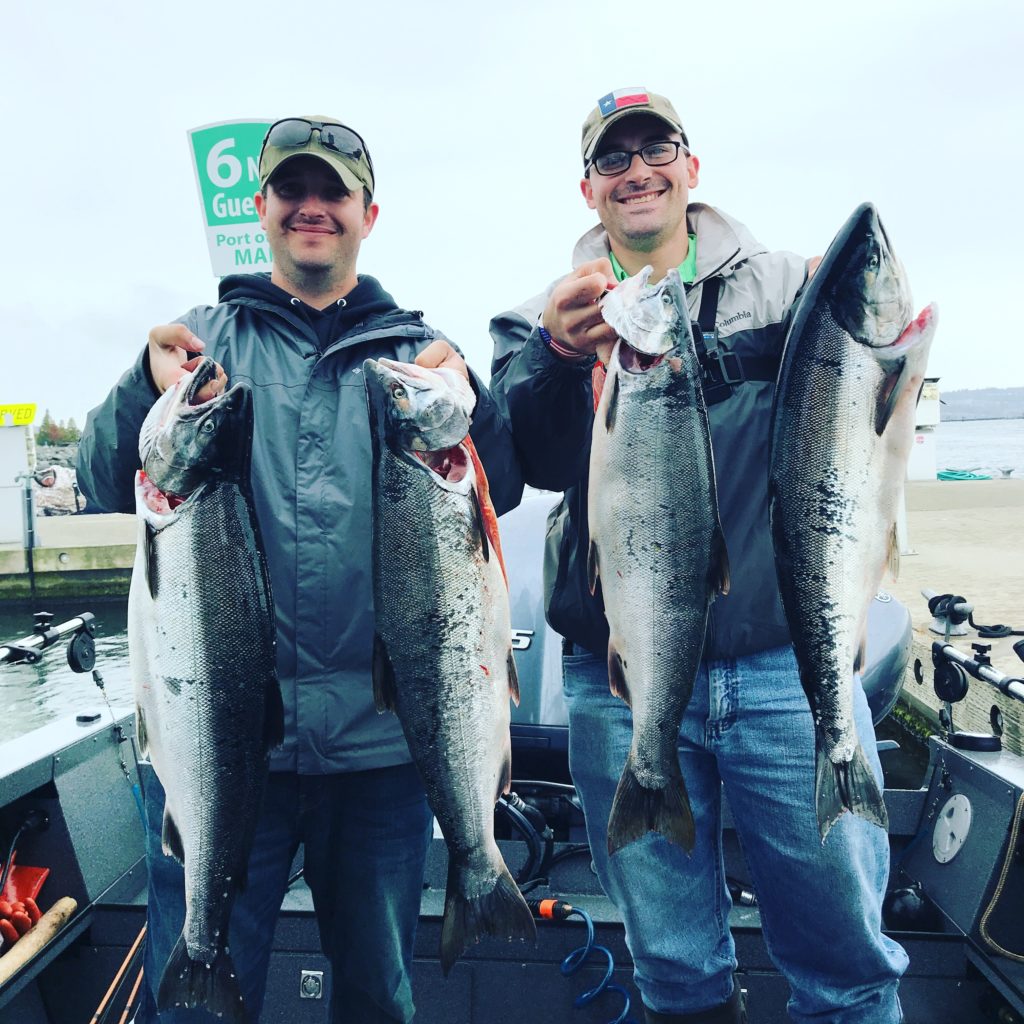
Often by early August, Marine Areas 9 and 10 may already be shut down for Kings due to the quotas being reached.
Starting in August, the coho will start to show up in good numbers in the Strait, and by the end of August, a significant number of these fish will be scattered throughout Puget Sound and can provide excellent coho/silver fishing.
One of the dynamics that begins in late August or early September, as we start to get a mix of rain, is that the Coho will stage outside of their natal rivers in great numbers until that first shot of rain brings river levels up a bit. Fishing in the salt will cool off considerably as the river heats up due to staging fish heading upriver.
In odd years, Pink Salmon will also be available timed between the King and Silver runs, with some overlapping of both. And if you are fishing in Marine Area 5, 6, or 7, you also have a slim chance at Sockeye throughout July and into August.
September is almost exclusively a coho program throughout Puget Sound. However, in Marine Area 13, the Kings may still go strong until mid-September around the Nisqually Delta.
Fall ( Oct-Dec) Puget Sound Salmon Fishing
October can still provide ok action for Silvers throughout Puget Sound as some of the big hook nose fish are still making their way to their spawning rivers.
October is also the month when the runs of Chum start to build in the South Sound and Hood Canal.
Chum can be an absolute blast to get at from the beach in places like Hoodsport or from other beaches along Hood Canal as the numbers of fish are usually epic.
Winter (Jan – Mar) Puget Sound Salmon Fishing
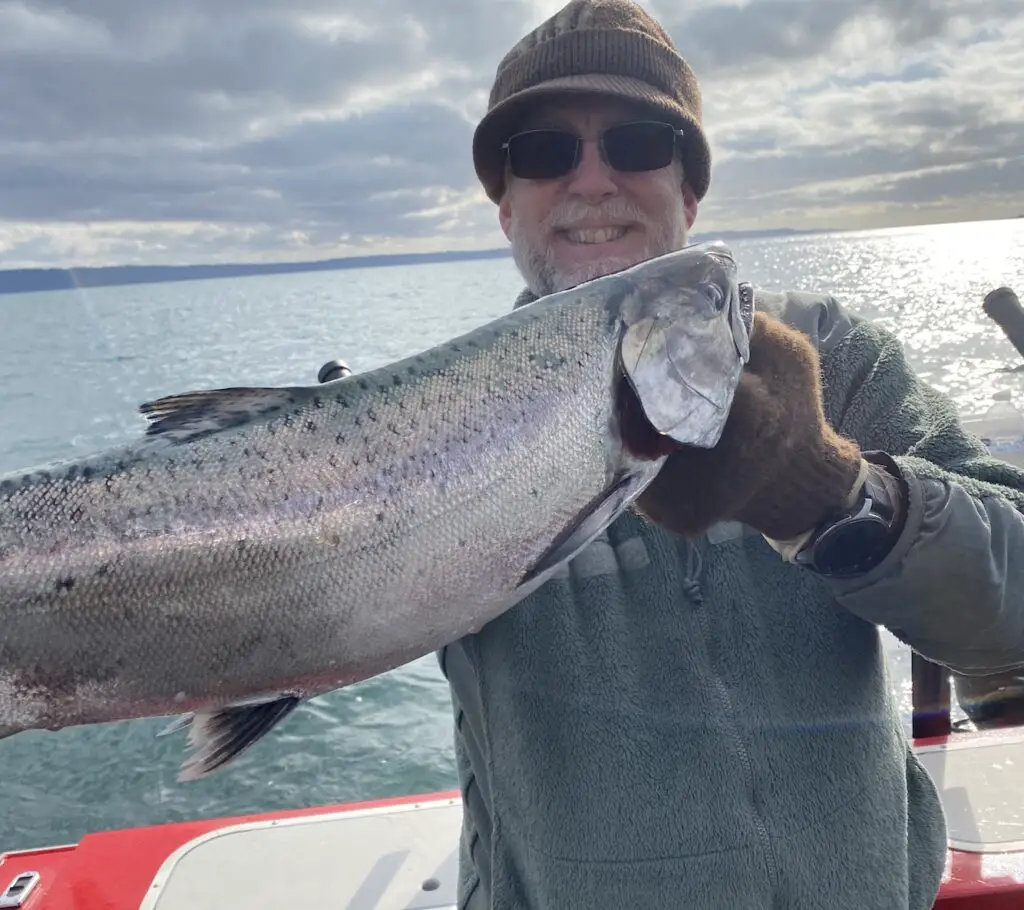
January through March can be epic for winter blackmouth if it’s open!
Due to the introduction of test fishing boats and sub-legal encounter quotas as a management tool in addition to pre-existing catch quotas, the blackmouth fishing opportunity has been drastically cut back.
The go-forward strategy starting in 2023 is to delay all the blackmouth opportunities until March and open all areas that can support a season at the same time. And in 2025, the seasons moved into April and out of March entirely.
This gives much of the sub-legal chinook a chance to migrate out of the areas anglers target the most during winter blackmouth seasons.
This may mean fewer bites, but ideally, the bites we do get will be nicer-sized salmon and that will also result in longer seasons.
You can read a lot more about winter blackmouth on our dedicated page for the topic.
Locations to fish for salmon around Puget Sound
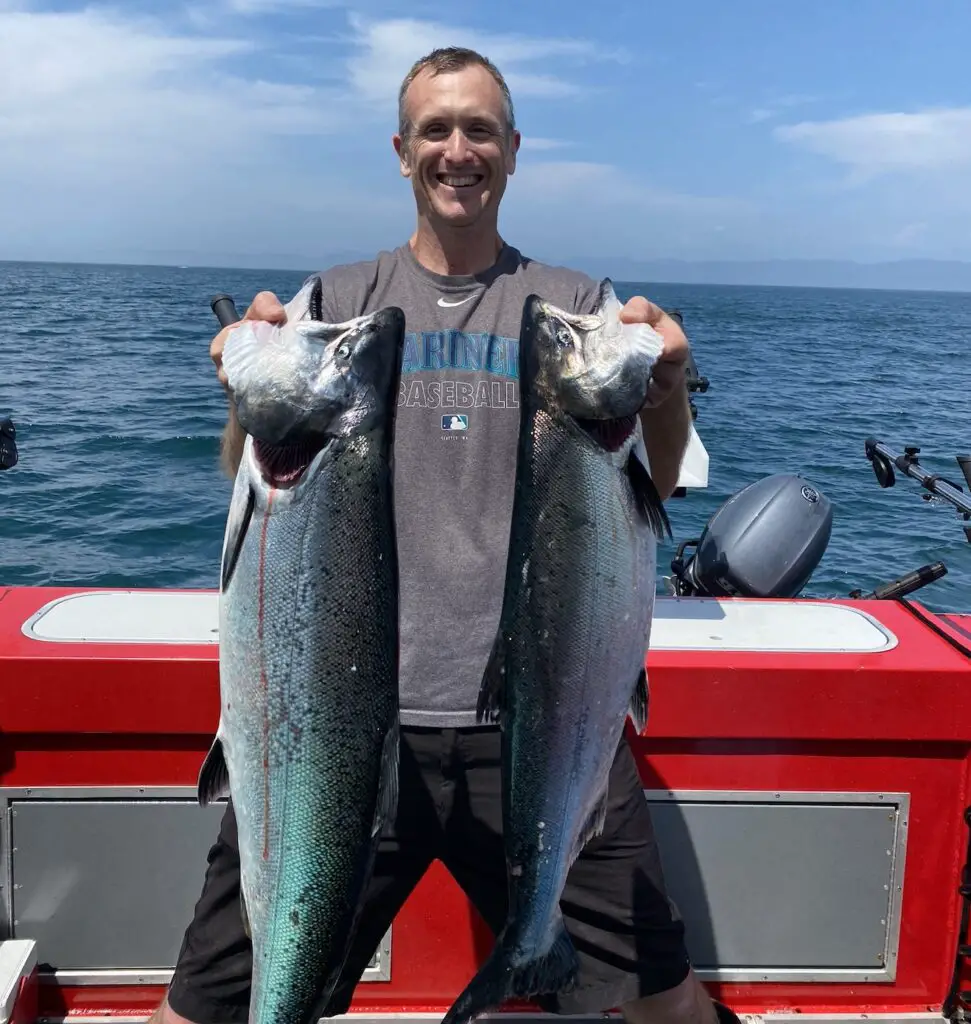
The Puget Sound and other saltwater adjacent to Washington State is divided up into Marine Areas by WDFW and in the official regulations. It makes sense to maintain those divisions in explaining a location strategy.
Marine areas will typically have specific rules and regulations dictating whether some species are available for harvest, the number, size limits, etc. By no means do I intend to cover every fishing location in every Marine Area, but to provide a few ideas for someone looking to get out in these areas. The Puget Sound Saltwater Journal book is a must-purchase to read and use as a reference for fishing the Puget Sound for Salmon.
Also, please consult the official regulations on the WDFW site for official Marine Area boundaries and definitions.
With all the Marine Areas we cover, there’s one very important concept to understand when pursuing salmon in Puget Sound.
In most cases, and when it comes to Kings, it’s all cases, you are only allowed to retain hatchery fish. These are fish missing their adipose fin. Also referred to as “marked fish,” as in marked for retention.
With this in mind, it truly pays to know where the hatcheries are, what rivers have hatcheries on them, and the strength of the run on that hatchery. The travel path of kings will generally be along structure lines throughout Puget Sound in route to their spawning stream and up to the hatchery.
Coho will take the open water route, crash into the beach around Edmunds/Oil Docks, and then turn towards their spawning streams.
- Marine Area 13 Chinook salmon
- Marine Area 12 / Hood Canal Salmon fishing
- Marine Area 11 Chinook Salmon Fishing
- Marine Area 10 Chinook Salmon Fishing
- Marine Area 10 Coho Salmon Fishing
- Marine Area 9 Chinook salmon
- Marine Area 7 Chinook salmon
- Marine Area 6 / Port Angeles fishing
- Marine Area 5 / Sekiu Salmon fishing
Rigging up for Salmon Fishing in Puget Sound
Rods and Reels for Puget Sound salmon fishing
There are many ways to go here that will lead to success. There are a few factors that I think are important:
- Budget – It’s not necessary to spend a significant amount on a setup for Puget Sound Salmon Fishing. Sure, you can always invest in nicer gear, but it’s not a critical factor in success
- Rod durability – Puget Sound fishing is something easy to share with your friends, your kids, and your friend’s kids…at some point, somebody will do something stupid with your rods. Make sure they can take a beating.
- Decent power, slow action, and somewhat sensitive tip – You are going to be fishing with 1/0 – 5/0 hooks, the rod needs enough backbone to penetrate larger hooks into a chinook jaw. If you are downrigger fishing, your rod will be in a crescent shape 90% of the time you are fishing, a stiff, fast-action rod here will not last. The sensitive tip is important, because when you get that slight bite that didn’t sick when using bait, or that 6″ shaker jumps on your line, you need to know so your chances of hooking a salmon aren’t neutralized. Miss the small take and you may be wasting your time, which is another reason to check your bait/lures every 15-20 minutes.
- Decent capacity for higher line diameter Reel. You may want to run a spool of 30 or 40-lb mono mainline (discussed below in the Line section). You may have a fish that pulls 100 yards of line on a blistering run in a few seconds. Requiring a spool capacity of up to 250+ yards of 30 lb mono is not a bad way to think about a reel requirement. If you are going to be downrigger fishing, reel weight is not that important either, since it’s not a rod-in-hand technique.
I run the Okuma Coldwater CW -303D line-counter reels. Having a line counter is not a requirement for Puget Sound fishing, though sometimes it can be helpful. But I also fish the same rods in the river, and certain techniques there can benefit from the line-counters.
I really like the low-profile line counter reel too, and that might be what I buy more of in the future.
For rods, I run the Okuma SST-C-1062MH. I’ve had great success with these. They’ve been dropped, bent nearly in half, and banged around. Great budget rod that will land a lot of fish for very little investment. The 1062MH is out of production now so the 1062 XH is probably what I would go with now.
Mainline for Salmon Fishing in Puget Sound
I love braid. I fish braid on all my river float rods and spinning setups.
Braid is fantastic for its durability with a small line diameter. It has almost no stretch, so the connection from rod and reel to terminal offering or fish is unmatched. It can also be a nightmare to deal with if you get it tangled.
Folks who really want braid on their reel will often fill their spool with it and then tie 100 yards of mono or fluorocarbon to the braid. Mono to braid is best tied together with an FG Knot.
I used to simply spool my reels with 30 lb mono mainline as a low-drama, low-hassle way to rig things up.
I now fill my spools with 50 lb braid and attach 100 yards of 30 lb fluorocarbon top shot with an FG knot. The primary reason I do this is to eliminate as much slack and stretch in my line as I primarily troll with downriggers, and this can be a big factor in not losing fish.
Flashers for Puget Sound salmon fishing
If you are trolling, you need to know about flashers.
The main goal of the flasher is to attract feeding salmon by attempting to look like the flash of other feeding salmon. There are many brands and styles, but whatever you go with, having a combination of both glow and UV is generally an approach you cannot go wrong with.
I’ve had great success with UV flashers just as the sun is coming up on a clear summer day, but that same flasher will not get hit 1-2 hours after first light as well.
Protroll even makes a lighted/blinking flasher that has some people really excited. I even caught a bird on a lighted flasher at 100 ft down!
Lures and Bait for Puget Sound salmon fishing
Length and type of line for the leaders is a factor based on the approach below.
Spoons
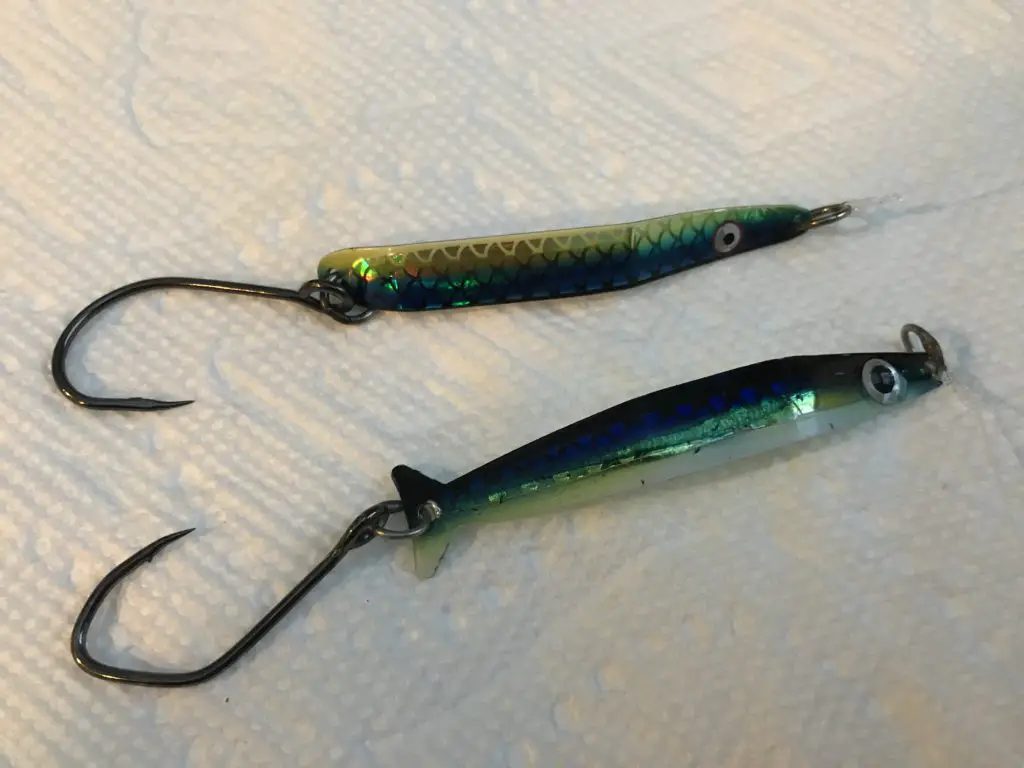
These days, trolling spoons is an incredibly popular technique that’s about as simple and straight forward as it gets.
Before I had any idea what I was doing, I tied up a Goldstar Kingfisher 3.0 spoon in the Cookies n’ Cream pattern, tied it to a 42″ leader.
Dropped it about mid-depth using downriggers and had my first Puget Sound king on a few minutes later. It’s not always that easy, but sometimes it is.
If you want to keep things incredibly simple, this is the way to do it. Even though I joke about Herring Aide being the only color pattern, there are many patterns that work, don’t be afraid to venture out and try other stuff.
One thing to keep track of with your spoons is the hook’s sharpness. It’s fairly easy to replace the hooks on these spoons if you see any rust or if you know one of them has been used and beaten up quite a bit. If you are getting strikes that aren’t sticking, this may be a reason.
My hooks on my spoons don’t last more than 2 trips. Replace often!
Hoochies
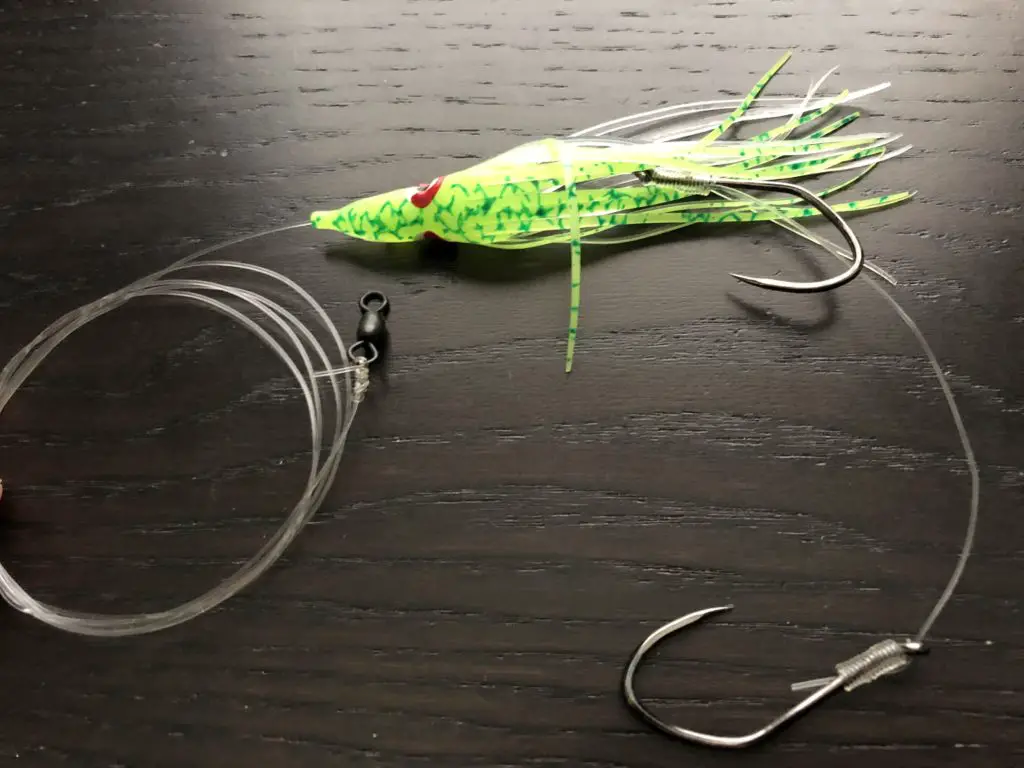
I seem to hook bigger fish on hoochies. I sometimes hook fewer, but they tend to be larger when running alongside an effective spoon. In the same category as hoochie is the incredibly effective Ace High Fly. These are lures that, unlike spoons, do not have their own action when trolled through the water. These lures are dependent on the flasher rotating around to impart the action that will draw a strike. For that reason, there’s a relationship between trolling speed, leader length, and leader stiffness.
I like to use at least 40-lb fluorocarbon to tie my hoochie or ace high fly leaders with. Some folks will even go up to 60 lb. You want a very stiff leader to ensure that the movement of the flasher will impart the right action.
For this reason, you also should keep leader length between 28 and 32″. If you intend to troll slower, say you are trying to fish deeper, or you have a bait presentation on the other side of the boat, ensuring you have a shorter leader will be helpful.
I tie mine up with several beads above the top hook so that it’s pushed down to the tail end of the hoochie. Running herring strips on the front hook of the hoochie rig is another way to increase your effectiveness, fishing with hoochies.
Bait
Running bait is the next level of mastery of Puget Sound Salmon Fishing. Bait presentations are a bit more technical, but still not too hard to get into and have some success. The primary goal is to get your bait to spin like a drill bit in the water column when trolled at your preferred speed. There are two basic approaches:
- Whole Herring or Anchovy
- Cut plug Herring
If you go with a whole herring, one of the easiest ways is to run them in a helmet. Not only do these helmets offer their own attraction qualities, but they largely take care of the spinning for you.
You can also run your whole baits without a helmet, but it takes a bit more work and practice to get it right.
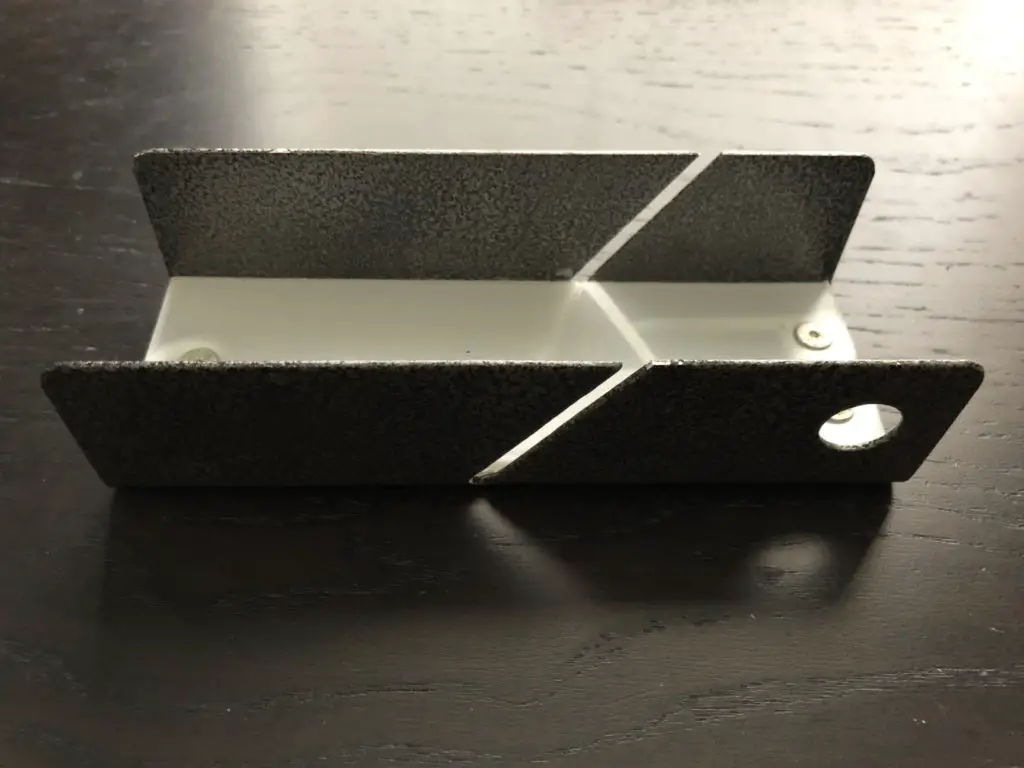
Cut plugging your herring is a great technique to learn, which has applicability from trolling to mooching and everything in between. While, there are masters of the craft who only need a sharp knife and a cutting board to produce awesome cut plug herring, the rest of us mortals use a miter box (like the above) for cutting to ensure a good cut plug.
A big question around this is what size of herring to use. You may have heard of orange, red, green, blue, and black label herring and wondered what it meant.
These are all different sizes of herring from orange (smallest) to black (largest). The size you go with is dependent on many factors, but in general, you are trying to match the hatch of what kind of herring is in the area you are fishing, that the Salmon are feeding on.
You also may want to err on the side of the smaller herring vs the larger size when trying to match the hatch. In general, herring during the winter are smaller in size and grow throughout the same growing season as salmon.
So during the winter, you may want to be using orange and red labels, but then switch to green and blue labels in the summer/fall. Smaller baits can achieve a good tight spin a bit easier, but larger baits are stiff, and have a bit more erratic action to them, which can make them great for plug cutting for mooching.
Orange or red label in a helmet can be a great and simple blackmouth goto bait presentation.
Boating vs Bank salmon fishing on Puget Sound
How you are going to access this incredible body of water? While the majority of this article caters to the person who has access to a boat, or thinking of buying a boat, there are many bank opportunities to access the Puget Sound.
Additionally, anyone without a boat should also consider hiring a guide/charter or fishing from the bank of the many rivers that are the intended destination of the salmon we angle for in Puget Sound.
However, river fishing for salmon is a separate article to cover in its entirety.
If you already own a boat…
Your only challenge to getting on the water is to figure out where you want to launch from, right? There are many launches to choose from with varying degrees of cost, upkeep, and ability to handle your boat.
Thinking of buying a boat for Puget Sound?
This is a fun topic to explore. Boats are like fishing rods in that they are designed for a specific purpose and generally do one or a few things really well and may not be good at other things.
You can go with something like the North River offshore series or the Duckworth offshore boats if you want a boat that can handle almost any kind of water / weather situation in the inland waters of Puget Sound.
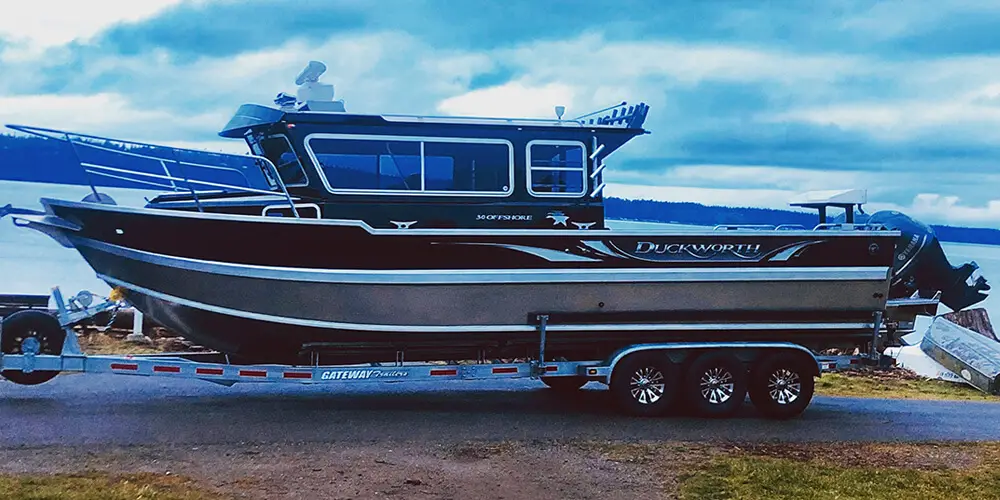
However, these types of boats also can be a bit overkill and may not be what you want. You may want to have the ability to launch on some of the smaller boat launches or have the flexibility to get into freshwater bodies of water such as lakes or rivers when you are not fishing Puget Sound, which cannot support a boat of that size.
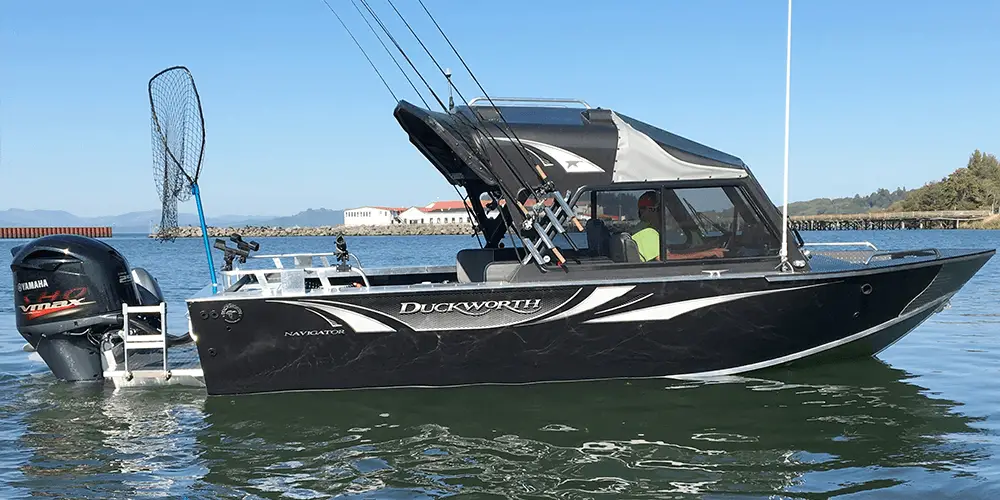
There are many boat manufacturers which make a boat like the above and it’s probably the most common type of boat I see on the sound. A boat with a mid vee like the above Duckworth can handle 95% of the water you want to be out fishing in, cut through chop and provide a comfortable experience on the water.
Boats larger than that usually offer a sleeping/kitchen option are are unnecessary for most Puget Sound day-trip fishing opportunities.
One of the primary factors you will be looking at is the degree of vee in the hull for being able to cut through chop and to handle larger wind waves safely while traveling throughout Puget Sound.

My first boat was a 20′ Alumaweld Stryker (pictured above) powered by a Jet outboard which has a shallower 14 degree vee.
This boat handles 80% of the conditions on the sound, but also allowed me to fish our rivers because of the Jet vs Prop lower unit.
I could fish the Strait in 2-3 foot wind waves near sheltered water. And just when I think I’m being brave, I also will see someone in the same conditions in a proverbial bathtub handling things just fine.
You may be shocked at what type of boat you will see out in certain conditions. Regardless of what you purchase, there’s no replacement for experience, and knowing your limits and the limits of your boat. See this blog post on navigating marginal conditions and understanding wind, and fetch, for an in-depth background on the topic.
I bought my boat that Alumaweld and my more recent North River Seahawk at 3 Rivers Marine in Woodinville, WA. They took good care of me and helped me not only make a purchase for what I was looking for, but they can also rig it up right for fishing. The people you deal with there spend a lot of time on the water themselves.
Mandatory Boat Accessories for Fishing the Puget Sound
These days there are two mandatory fishing accessories (there are many other safety/comfort-related accessories) you shouldn’t skimp on: Electronics and downriggers
Electronics
Fish finders and Sonar allow you to scan the water below or around your boat to identify salmon or other larger fish, as well as smaller critters such as herring, squid or even shrimp.
You will also be able to read water depths, and surface water temperature and see structure, which are all important for effective fishing. This setup involves a display unit and wiring to a transducer that is performing the actual scanning.
Make sure your display unit is fully visible to where you will be driving the boat, especially from where you will be handling your trolling motor. Also, consider getting the largest display unit your pocketbook can handle.
Downriggers
While there are a number of ways to fish without downriggers, covered later in the article, 90% of the boats I see on the sound are using these and it’s also my technique of choice when pursuing salmon in the Sound. And even if you prefer other techniques, why spend all that money on a boat and not the additional few hundreds dollars on downriggers?
Downriggers allow you to fish much deeper in the water column via use of a large weighted downrigger ball (typically 8-18 lbs) and release mechanism that attaches to your mainline, but will release when a fish bites, allowing you to fight the fish, completely free of the heavy downrigger ball.
Banking it all the way
There are two or three basic choices you have in tackling Puget Sound salmon fishing from the bank.
- Fishing from the many publicly accessible beaches around Puget Sound
- Fishing from the several piers on the Puget Sound
- Fish on the rivers which dump into the Sound (covered separately)
Fishing from the beach
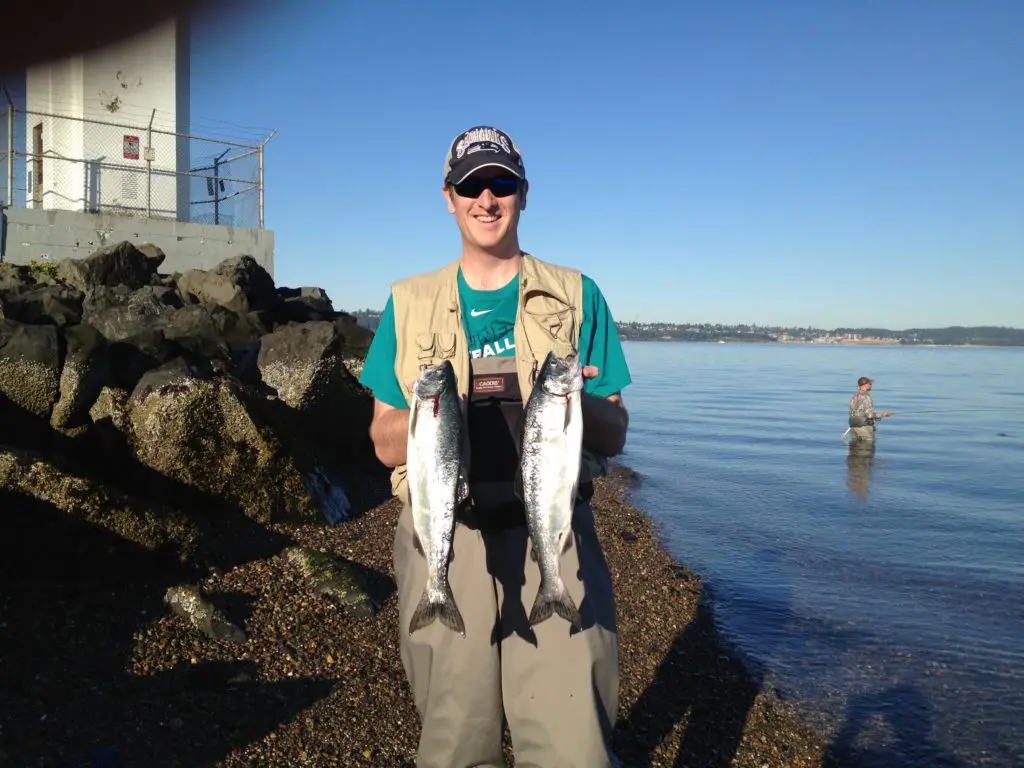
There are many many beaches to choose from and several techniques to choose from.
- Fly fishing
- Tossing lures such as spinners, buzz bombs, and jigs such as Point Wilson darts
- Tossing bait under a float or mooching sinkers
Fishing from a pier
Bring your patience and compassion for your fellow angler as you will most certainly have company and be fishing in close quarters.
I have always fished fresh water. Now retired and living in Bremerton, want to get in On the action. Any guidance suggestions, advice appreciated. Thanks. Retired Navy, retired Civil Service Welder.
Terry,
Thanks for taking the time to read my page an comment! Also, thank you for your service! Do you have a boat or are you strictly seeking bank / pier opportunities?
-Kyle
Retirement really suits you Dude!
I am now a Washington resident but still sorting out my own retirement plans.
– Brad
Do you have proof that mooching was invented on Puget Sound? I know that the technique was used at the mouth of the Columbia River since at least the early 1900’s — probably earlier. Almost all early sportfishing would have been by mooching with the current back in the sailboat and rowboat days, although most folks were commercial fishing back then. My dad claimed to have been the first to paint mooching sinkers — probably back in the 1930’s. He taught me to mooch in the 1960’s. He had obviously been doing it a long time at that point.
Mark,
That’s a great question / point…I don’t have any firsthand knowledge or proof, but more relaying what I’ve heard from multiple sources. The reference was to people in boats coming back to the dock after trolling all day and being skunked asking the dock folks if they could “mooch” off of their herring they were using to get lots of salmon. I bet the technique had been in circulation long before the Puget Sound area coined the term “mooching” if indeed that’s the true origin. I would be curious to know.
Thanks,
Kyle
Kyle,
First off your blog or website or whatever you are calling it these days is great. I just want to say that I grew up fishing out of Gloucester Massachusetts, but now have been living around Seattle for 8 years. It has taken a long time to figure out access to these waters but I finally pulled it off. What I don’t know is Puget Sound fishing. I know jigging for cod, haddock, pollack, wolf fish, trolling for stripers, blue fish, bottom fishing for anything that takes a sea worm – or clam which on the east coast is almost everything. I also did a stint on commercial boats gill netting and dragging but that is another story. Rec fishing here is different. I don’t know if you still get these messages but if you ever have space on a boat and need someone to fill in. I would love to learn.
Thanks David!
My boat is really full this summer already with friends and family going out on trips with me and it’s super hard for me to keep track of everyone who reached out looking for a trip. What I would say is keep in touch with me on IG @pacificnwbestlife there or on facebook.com/pnwbestlife. When something comes up, you never know!
The content on the blog is geared at helping someone like you go out and catch a salmon, steelhead or bottomfish on your own as well. So let me know if you have a question about something I can help with.
Thanks!